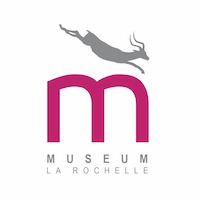Born in Saint-Domingue (Haïti today) in 1785, brought up in France, then an immigrant in the USA in 1806, Audubon undertakes making an inventory and representation of all the birds of the country and of its Native American outskirts. At the cost of a nomadic, adventurous and difficult life he manages to carry out a monumental work, “The Birds of America”. It is engraved, printed and colored in Edinburgh, Scotland, and London between 1827 and 1838. First recognized in England and France, it is now universally valued as a major masterpiece combining art and science.
From 1788 to 1796 Audubon’s childhood is spent in Nantes and La Gerbetière, the beautiful family mansion bought in Couëron on the Loire riverbank in tune with a rich, natural landscape that he discovers with his father Jean Audubon. The latter, then a Navy Lieutenant, first plans a career in the Navy for his son. Yet, the long years of training spent in the Arsenal of Rochefort end up in failure. Back home in Nantes and Couëron, Jean-Jacques resumes his hobbies as a naturalist. From 1801 or 1802 he benefits from the friendship of Charles-Marie Dessalines d’Orbigny, the family doctor.
It is the moment when Jean Audubon decides to send his son to the USA in 1803 to manage his estate in Mill Grove near Philadelphia. Jean-Jacques crosses the Atlantic Ocean but doesn’t get on well with Francis Dacosta the co-manager of the estate and comes back to France. He has taken advantage of his stay to be initiated to the American Fauna and brings a series of drawings of mammals and American birds back to Nantes. He meets up with Doctor d’Orbigny and with him broadens his scientific knowledge and his approach of animal drawing.
However his father doesn’t give up on his American project. He negotiates a contract for his son, in association with Ferdinand Rozier, the son of a rich merchant in Nantes, so that both young men can set up business in the USA. Jean-Jacques himself wishes to go back to Mill Grove, to marry Lucy Bakewell he had met during his first stay. On April 12th 1806, Jean-Jacques sets sail for the US. He will never see his family nor La Gerbetière again. It is most probably the moment when he gave the drawings found in La Rochelle to d’Orbigny.
Once in the US, he gets rid of Mill Grove and heads for the west to set up a counter near the Ohio River. It is only in 1820, after a series of successes and failures that he decides to quit his activities as a business man, in order to devote himself entirely to his scientific and artistic project without any backing support except from his wife Lucy and occasionally a few friends.
In the USA, recognition for his work will come after Europe’s and Audubon will be able to establish his family on the then rural Hudson riverbank in New York where he will die in 1851. This appreciation will keep growing, leading to the creation of the first Audubon Society for the protection of birds in Massachusetts in 1896, soon followed by many others that united in the National Audubon Society, a still very lively and busy Society nowadays.








